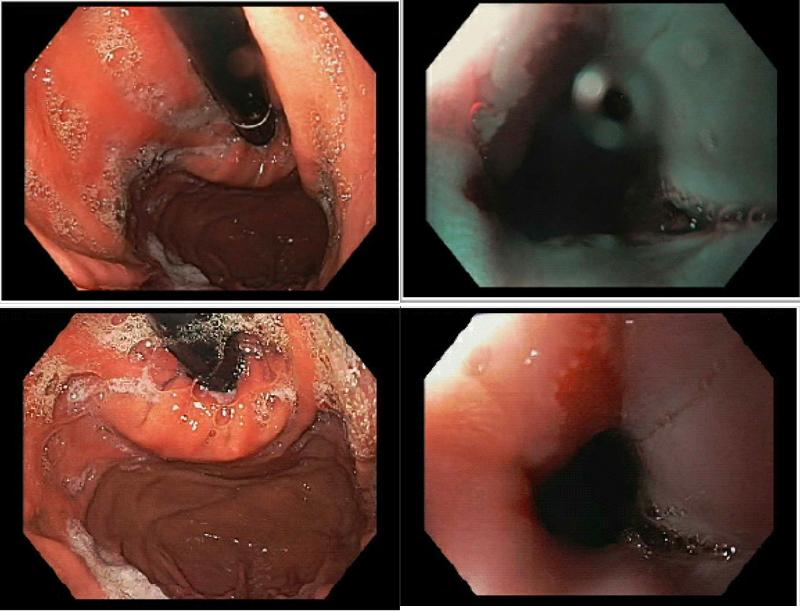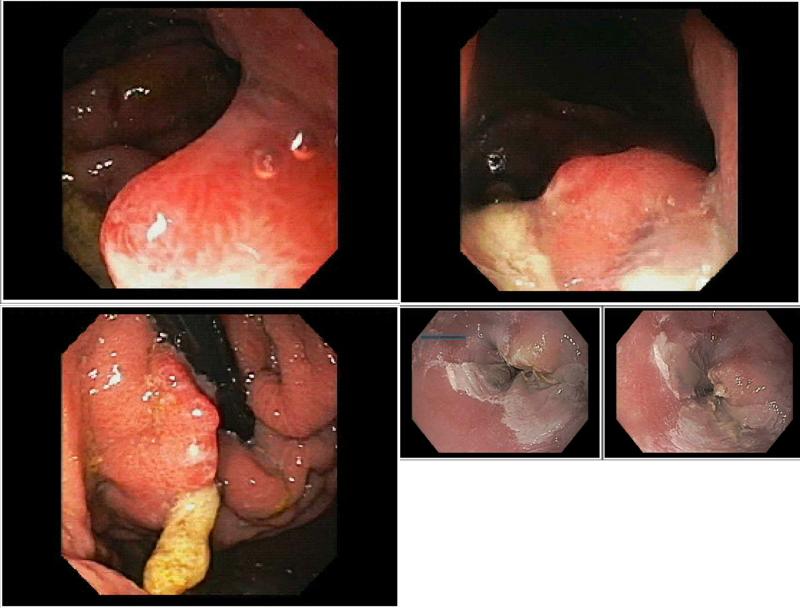Tuesday Poster Session
Category: Esophagus
P4994 - Advanced Esophageal Adenocarcinoma Presenting as Dysphagia in a Middle-Aged Male
Tuesday, October 28, 2025
10:30 AM - 4:00 PM PDT
Location: Exhibit Hall

Thomas Barker, MD
Michigan State University
East Lansing, MI
Presenting Author(s)
Thomas Barker, MD1, Caleb Glover, DO2, Ali Rida, MD2, Edward Cay, DO3, Claire C. Russell, DO2, Jannel Lee-Allen, MD, MUP, FACG2
1Michigan State University, East Lansing, MI; 2McLaren Greater Lansing Hospital, Lansing, MI; 3McLaren Greater Lansing, Lansing, MI
Introduction: Esophageal adenocarcinomas at the GEJ are increasingly prevalent, particularly among patients with chronic gastroesophageal reflux disease (GERD), obesity, and metabolic syndrome. Despite surveillance protocols, early disease may elude detection due to its submucosal origin or nonspecific presentation. Timely recognition is essential to impact outcomes in this aggressive cancer subtype.
Case Description/
Methods: A 54-year-old male with diabetes, obesity, hyperlipidemia, and prior cholecystectomy presented with months of reflux and epigastric discomfort. An outpatient esophagogastroduodenoscopy (EGD) in December 2024 showed no abnormalities and no malignancy on biopsy. Three months later, he returned with progressive dysphagia. Repeat EGD revealed a stenotic distal esophagus and a friable, fungating mass extending to the cardia. Biopsies confirmed poorly differentiated adenocarcinoma with lymphatic invasion. Nutritional support via jejunostomy was attempted but was complicated by functional obstruction and severe abdominal pain, requiring surgical revision and decompressive gastrostomy placement. The patient’s clinical status rapidly declined; he developed jaundice, bilateral pleural effusions, and worsening hypoxia. Cytology from thoracentesis confirmed metastatic adenocarcinoma. Contrast enhanced CT imaging demonstrated a new 1.6 cm hepatic lesion and an enlarged pancreatic lymph node measuring 2.6 cm. He expired in April, before he was able to start treatment, less than four months after initial negative endoscopy.
Discussion: This case illustrates an extraordinarily aggressive progression of esophageal adenocarcinoma, transitioning from normal endoscopy to widespread metastatic disease in under 120 days. Rapid evolution of symptoms despite negative early workup suggests potential sampling limitations or early subepithelial tumor infiltration. Poorly differentiated tumors are associated with early dissemination and limited response to intervention. This case emphasizes the importance of high clinical suspicion, particularly in patients with multiple risk factors and evolving symptoms. Prompt reassessment and multidisciplinary involvement may offer the best chance for early diagnosis and therapeutic intervention in such aggressive cases

Figure: Normal EGD in December

Figure: Abnormal EGD in March
Disclosures:
Thomas Barker indicated no relevant financial relationships.
Caleb Glover indicated no relevant financial relationships.
Ali Rida indicated no relevant financial relationships.
Edward Cay indicated no relevant financial relationships.
Claire Russell indicated no relevant financial relationships.
Jannel Lee-Allen indicated no relevant financial relationships.
Thomas Barker, MD1, Caleb Glover, DO2, Ali Rida, MD2, Edward Cay, DO3, Claire C. Russell, DO2, Jannel Lee-Allen, MD, MUP, FACG2. P4994 - Advanced Esophageal Adenocarcinoma Presenting as Dysphagia in a Middle-Aged Male, ACG 2025 Annual Scientific Meeting Abstracts. Phoenix, AZ: American College of Gastroenterology.
1Michigan State University, East Lansing, MI; 2McLaren Greater Lansing Hospital, Lansing, MI; 3McLaren Greater Lansing, Lansing, MI
Introduction: Esophageal adenocarcinomas at the GEJ are increasingly prevalent, particularly among patients with chronic gastroesophageal reflux disease (GERD), obesity, and metabolic syndrome. Despite surveillance protocols, early disease may elude detection due to its submucosal origin or nonspecific presentation. Timely recognition is essential to impact outcomes in this aggressive cancer subtype.
Case Description/
Methods: A 54-year-old male with diabetes, obesity, hyperlipidemia, and prior cholecystectomy presented with months of reflux and epigastric discomfort. An outpatient esophagogastroduodenoscopy (EGD) in December 2024 showed no abnormalities and no malignancy on biopsy. Three months later, he returned with progressive dysphagia. Repeat EGD revealed a stenotic distal esophagus and a friable, fungating mass extending to the cardia. Biopsies confirmed poorly differentiated adenocarcinoma with lymphatic invasion. Nutritional support via jejunostomy was attempted but was complicated by functional obstruction and severe abdominal pain, requiring surgical revision and decompressive gastrostomy placement. The patient’s clinical status rapidly declined; he developed jaundice, bilateral pleural effusions, and worsening hypoxia. Cytology from thoracentesis confirmed metastatic adenocarcinoma. Contrast enhanced CT imaging demonstrated a new 1.6 cm hepatic lesion and an enlarged pancreatic lymph node measuring 2.6 cm. He expired in April, before he was able to start treatment, less than four months after initial negative endoscopy.
Discussion: This case illustrates an extraordinarily aggressive progression of esophageal adenocarcinoma, transitioning from normal endoscopy to widespread metastatic disease in under 120 days. Rapid evolution of symptoms despite negative early workup suggests potential sampling limitations or early subepithelial tumor infiltration. Poorly differentiated tumors are associated with early dissemination and limited response to intervention. This case emphasizes the importance of high clinical suspicion, particularly in patients with multiple risk factors and evolving symptoms. Prompt reassessment and multidisciplinary involvement may offer the best chance for early diagnosis and therapeutic intervention in such aggressive cases

Figure: Normal EGD in December

Figure: Abnormal EGD in March
Disclosures:
Thomas Barker indicated no relevant financial relationships.
Caleb Glover indicated no relevant financial relationships.
Ali Rida indicated no relevant financial relationships.
Edward Cay indicated no relevant financial relationships.
Claire Russell indicated no relevant financial relationships.
Jannel Lee-Allen indicated no relevant financial relationships.
Thomas Barker, MD1, Caleb Glover, DO2, Ali Rida, MD2, Edward Cay, DO3, Claire C. Russell, DO2, Jannel Lee-Allen, MD, MUP, FACG2. P4994 - Advanced Esophageal Adenocarcinoma Presenting as Dysphagia in a Middle-Aged Male, ACG 2025 Annual Scientific Meeting Abstracts. Phoenix, AZ: American College of Gastroenterology.
